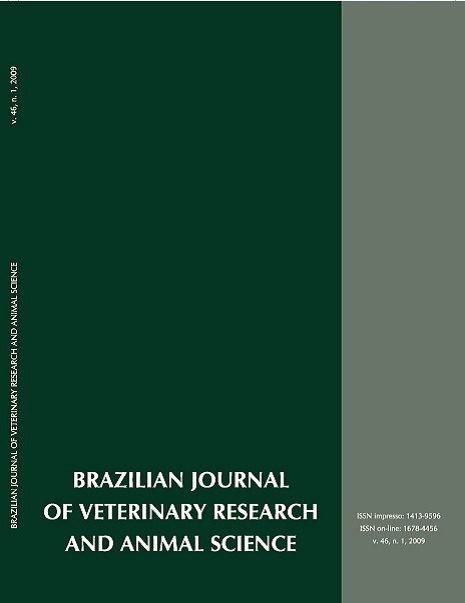Seminal characteristics of rams supplement or not with urea and two sources of sulphur
DOI:
https://doi.org/10.11606/issn.1678-4456.bjvras.2009.26750Keywords:
Sheep, Reproduction, Nutrition, Semen, Nonprotein nitrogenAbstract
Twelve adult Santa Inês crossbred rams with similar weight and age employed in a randomized design for 60 days period to evaluate three treatments: A. 100% of degradable protein requirement (control); B. 100% of degradable protein requirement + 3% urea + inorganic sulphur (99%S) and C. 100% of degradable protein requirement +3% urea + organic sulphur (21,5% S). Every week seminal collections were made through artificial vagina; blood collections were made to analyze plasma N-ureic levels and measured live weight and scrotal circumference. In semen samples were studied volume, microscopic waves, vigor, motility, concentration, total sperm per ejaculate, total feasible sperm per ejaculate, membrane sperm integrity, acrosomal integrity, percent of abnormal spermatozoa and N-ureic level in seminal plasma. Treatments experimental animals receiving presented blood and seminal plasma N-ureic levels higher than the ones of control treatment (p < 0,05). There was significant difference between organic and inorganic sources of sulphur in the following semen characteristics (p < 0,05): treatment C presented microscopic waves (4,57), motility (85,69%), vigor (4,66) and total sperm per ejaculate (9,02 x 10(9)) higher than treatment B; and the percentage of secondary sperm abnormality (5,37%) was lower than treatment B.Downloads
Download data is not yet available.
Downloads
Published
2009-02-01
Issue
Section
UNDEFINIED
License
The journal content is authorized under the Creative Commons BY-NC-SA license (summary of the license: https://
How to Cite
1.
Hamilton TR dos S, Lucci C de S, Madureira EH, Narimatsu S, Goulart RH, GIL J, et al. Seminal characteristics of rams supplement or not with urea and two sources of sulphur. Braz. J. Vet. Res. Anim. Sci. [Internet]. 2009 Feb. 1 [cited 2024 Jul. 26];46(1):54-61. Available from: https://www.revistas.usp.br/bjvras/article/view/26750





